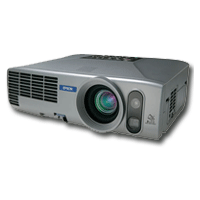Video Projector Guide
By Riad Haddad
Well; the world of Projection is certainly a vast place to wonder uninformed, so get informed. I will try to keep this guide as simple as possible.
Things to look for when buying a projector:Manufacturer/MakeThere are many projector manufacturers these days that make it seem impossible to choose from. But to make it simpler, many manufacturers now a days use parts that are supplied from other manufacturer. In other word not all the parts in a projector is manufactured by the same manufacturer. Thus many projectors already have similar components incorporated into them. Always read reviews posted on computer magazines and online computer magazines before purchasing high end/high priced projector. Look for a company that offers the best warranty & support. Brands like Sony, Panasonic, Toshiba, Sharp, In-focus, View sonic, Mitsubishi, Epson are amongst the best there is.
TechnologyThere are many technologies available today. But the main two types are LCD & DLP. In simple DLP which stands for Digital Light Processing uses hair width tiny mirrors to reflect light into a screen. DLP offer better overall image but cost a lot more. So for home users its better to opt for LCD based projector because of there much lower price and higher availability. Also LCD projector offer excellent image that is comparable to DLP. Big companies and presentation oriented businesses well find DLP a better choice. There are also projections panels. Projections panels are a form of transparent display that are placed over an ordinary Overhead projector and used to project the same type of video sources that normal projector use. Projection panels are cheaper than the types described earlier.CRT Projectors are an old projection technology that is no longer used these days.
ResolutionResolution is very important aspect to consider when purchasing a projector. Many older models are VGA (640*480) & SVGA (800*600); these models are good for displaying movies and other low resolution images, but will no be sufficient for projecting high quality images demanded by high end application such as 3d modeling, games, simulators and CAD. Check the simple chart below:
640*480 (VGA) resolutions are good for Video Games, VHS, VCD and Standalone DVD users. This panel is perfect for DIYers wanting to keep costs at lowest.800*600 (SVGA) resolutions are perfect for Computer based DVD playback and normal Windows and operation system work. (Plus all the above)1024*768 (XGA) resolution is perfect for high resolution Computer Games and design applications such as AutoCAD (plus all the above)1280*1024 (SXGA) resolution is perfect for HDTV applications and computer software that require high detail (plus all the above)
Color DepthColor depth states how good the LCD represents color. Its the number of colors a monitor or an LCD panel is able to show. A good color depth is 16-Bit; although 24-Bit is strongly advised, this is the color depth that most high end projection panels have.
Lamps An important thing to investigate is the type of lamp used. Check the replacement price of lamps and life expectancy. It would make you no good if you purchase a low price projector and later find out that every lamp replacement will cost you 400$. New lamp models can work for a minimum of 10,000 hrs.
BrightnessBrightness output is expressed in lumens. The higher the lumens the better the image is displayed in less than perfect lighting conditions. Some new projector models can display a vivid image even with the light on. 2000 lumens is a good choice for home use. Choose 3000-4000 for presentation theaters and jobs that require a bright image in a not too darkened room. Lumens rating of below 2000 such as the low priced 1300 models will have to be operated in a completely darkened room (Pitch Black).
ConnectionsConnections are a very important factor when choosing a projector. Composite, S-Video and RGB is almost standard on most models. You will need RGB for hooking your computer or laptop; Composite & S-Video for connecting DVD players and VCRs. Some newer models have DVI inputs too that enable them to be connected to high quality video systems like a video editor or digital video cameras. A remote control is a must; you don't wan to get out of your comfy chair every five minutes. Some applications require two RGB connections for simultaneous viewing of different video sources, so make sure to check for it if you need it.
Long throw/Short throw projectionIts important to decide where you are going to place the projector. If the projector is going to be placed in front of an audience then you will need a short throw projector. And if you need to fix the projector some where behind the audience (Far from screen) you will need a long throw projector. What happens when you use short throw projector for a behind the audience application is that the image will be too large to fit on screen, and if you use a long throw projector for short distances you will get a very small and unclear image.
DIY ProjectorsWell this is interesting. Did you know that you can build a projector yourself, its not that hard really and it will cost you a fraction of retail prices? You should have basic knowledge with DIY projects. The image quality is very good you won't believe it. Though some patience is required in order to complete the projector.
-------------------------------------------------------------------------------------------------------
** You are free to publish this article by any delivery method you see fit. But you are kindly asked keep the article intact and as is.
Riad Haddad is a Software Developer and Internet Marketer specializing in state of the art custom solutions; from database development to website marketing.
www.fitsoftinc.com
Article Source: http://EzineArticles.com/?expert=RiadHaddad
http://EzineArticles.com/?Video-Projector-Guide&id=324767


0 comments:
Post a Comment